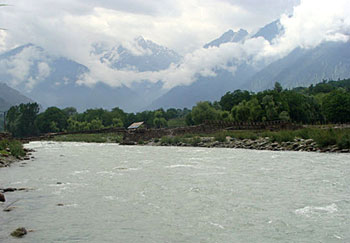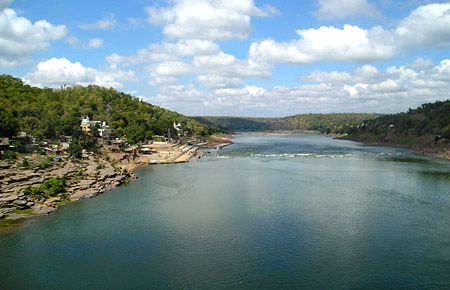 India in its original Persian sense meant the Sindhu River. The Greeks called it Indos, and by derivation, all the land lying beyond the Indus, both the Northern plains and the Deccan was given this name. The most ancient part of this vast country is the Deccan - which was an island when Hindustan was still under the sea. A volcanic upheaval which had submerged ancient lands gave the Deccan the peninsular shape, while in the north cretaceous sea-bottoms not only appeared above the water but rose to great heights.
India in its original Persian sense meant the Sindhu River. The Greeks called it Indos, and by derivation, all the land lying beyond the Indus, both the Northern plains and the Deccan was given this name. The most ancient part of this vast country is the Deccan - which was an island when Hindustan was still under the sea. A volcanic upheaval which had submerged ancient lands gave the Deccan the peninsular shape, while in the north cretaceous sea-bottoms not only appeared above the water but rose to great heights.
The Himalayan Mountains bounds India on the north, in a crescent tilted from north-west to south-east. India is closed on the north of its great river basins and on the east of Bengal. In the west, the right bank of the Indus is dominated by the highlands of Afghanistan and Baluchistan. The rest of the country is surrounded by the sea southwards. It grows very much narrow. The Deccan step at the Nilgiri Hills, east of Kozhikode, however is continued in a subsidiary massif which forms Cape Camorin. On the North it begins on the southern slope of the contrary valleys of the River Son and the River Narmada. Along the sides of the plateau run the Western Ghats and the Eastern Ghats. Along the northern edge of the Deccan are the Vindhya Mountains, which extend from the northern slope of the valley of the Narmada to the plains of the Ganges. In the west the Arravalli are the highest part of the terrace.
 The rivers of the Deccan have broken the line of the Eastern Ghats into sections. The Himalaya itself is pierced by the Indus and its tributary the River Sutlej. The five rivers of the upper basin of the Indus are like a delta upside down while the lower course of the river is between two torrid deserts. The Ganges runs through fertile land and collects the streams of the whole southern slope of the Himalaya.
The rivers of the Deccan have broken the line of the Eastern Ghats into sections. The Himalaya itself is pierced by the Indus and its tributary the River Sutlej. The five rivers of the upper basin of the Indus are like a delta upside down while the lower course of the river is between two torrid deserts. The Ganges runs through fertile land and collects the streams of the whole southern slope of the Himalaya.
Geography of India has affected the course of her history and culture in several ways. The spirit of tolerance has been nurtured and fostered both, directly and indirectly by India`s geography. The vastness of the land and its climate has influenced the Indian mind. This has prepared in the mind a readiness to accept difference. The vast spaces offered room for slow infiltration by newcomers and allowed each locality, unhampered scope of development along its own lines. Indian climate generally makes one lethargic.
India`s geographical isolation and natural frontiers have given her sense of unity. The internal cohesion is matched by India`s sharp differentiation from all external lands. Nature has generously endowed her boundaries which has all the resources that man needs for a civilised and creative life. Common economic organisation has led to the development of common characteristics and a common outlook.
The geography of India explains the fundamental basis of Indian culture, unity amidst diversity. Simultaneously Indians have a genuine love of the soil and its fauna and flora, its rivers, mountains and valleys, its teeming life and ceaseless activity. It roused a geographical consciousness, a realisation of the territorial basis of the life of society. The religious culture is rooted to the soil. Geography and culture are intimately related. The conception of motherland was expressed by the name Bharat Varsha for the whole country. It was regarded as the Karmabhumi, the land with which all the efforts and activities of the Indians must be connected.



















